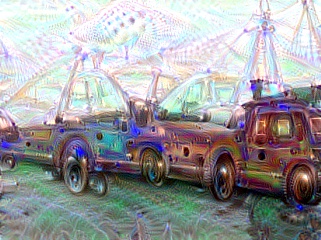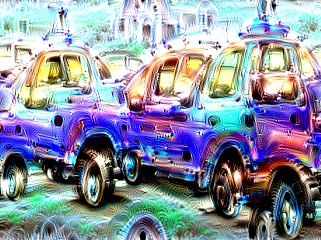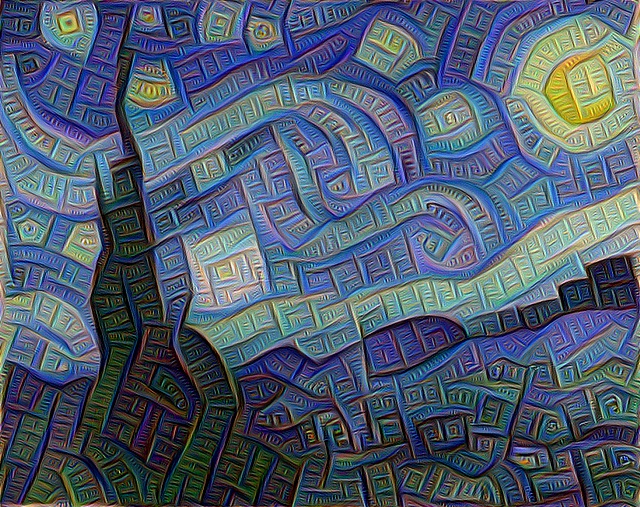【深度學習】谷歌deepdream原理及tensorflow實現
什麼是DeepDream?
DeepDream是谷歌釋出的對卷積神經網路(CNN)進行視覺化的方法,當然它的用途不僅限於此,我們可以通過它讓機器“做夢”,以下是一些效果:
可以看到計算機將自然影象的一些特徵放大,生成了它想想中的一些物體。利用這個特點還可以生成一些從未有過的物體:
DeepDream的原理
卷積神經網路由於其從理論上難以解釋,一直被很多學者詬病。在2013年“Visualizing and Understanding Convolutional
Neural Networks”這篇文章提出了使用梯度上升的方法視覺化網路每一層的特徵,即用一張噪聲影象輸入網路,反向更新的時候不更新網路權重,而是更新初始影象的畫素值,以這種“訓練影象”的方式
之前說過,deepdream需要放大影象特徵。比如:有一個網路學習了分類貓和狗的任務,給這個網路一張雲的影象,這朵雲可能比較像狗,那麼機器提取的特徵可能也會像狗。假設對應一個特徵[0.6, 0.4], 0.6表示為狗的概率, 0.4表示為貓的概率,那麼採用L2範數可以很好達到放大特徵的效果。對於這樣一個特徵,L2 = x1^2 + x2^2,若x1越大,x2越小,則L2越大,所以只需要最大化L2就能保證當x1>x2的時候,迭代的輪數越多x1越大,x2越小,所以影象就會越來越像狗。每次迭代相當於計算L2範數,然後用梯度上升的方法調整影象。當然不一定要一張真實的影象,也可以從一張噪聲影象生成夢境,只不過生成的夢境會比較奇怪。
以上是DeepDream的基本原理,具體實現的時候還要通過多尺度、隨機移動等方法獲取比較好的結果,在程式碼部分會給出詳細解釋。
DeepDream的tensorflow實現
實現參考:tensorflow/example/tutorial
首先是下載google的inception模型,tensorflow_inception_graph.pb 是模型檔案。
然後定義計算圖,載入模型,將輸入的placeholder加入計算圖中,並定義L2範數和其對於原始影象的梯度。def get_model(): """download model""" model = os.path.join("model", model_name) if not os.path.exists(model): print("Down model...") os.system("wget https://storage.googleapis.com/download.tensorflow.org/models/inception5h.zip -P model") os.system("unzip model/inception5h.zip -d model") os.system("rm model/inception5h.zip") os.system("rm model/imagenet_comp_graph_label_strings.txt") return model
# define graph
graph = tf.Graph()
sess = tf.InteractiveSession(graph=graph)
# load model
with tf.gfile.FastGFile(model, "rb") as f:
graph_def = tf.GraphDef()
graph_def.ParseFromString(f.read())
# define input
X = tf.placeholder(tf.float32, name="input")
X2 = tf.expand_dims(X - imagenet_mean, 0)
tf.import_graph_def(graph_def, {"input": X2})
# L2 and gradient
loss = tf.reduce_mean(tf.square(graph.get_tensor_by_name("import/%s:0" % layer)))
gradient = tf.gradients(loss, X)[0] for i in range(octave_num - 1):
size = np.shape(image)[:2]
narrow_size = np.int32(np.float32(size) / octave_scale)
# down sampling and up sampling equal to smooth, diff can save significance
down = resize(image, narrow_size)
diff = image - resize(down, size)
image = down
octaves.append(diff) def cal_gradient(image, gradient):
"""cal gradient"""
# generate offset and shift to smooth tile edge
shift_x, shift_y = np.random.randint(tile_size, size=2)
image_shift = np.roll(np.roll(image, shift_x, 1), shift_y, 0)
total_gradient = np.zeros_like(image)
# calculate gradient for each region
for y in range(0, max(image.shape[0] - tile_size // 2, tile_size), tile_size):
for x in range(0, max(image.shape[1] - tile_size // 2, tile_size), tile_size):
region = image_shift[y:y + tile_size, x:x + tile_size]
total_gradient[y:y + tile_size, x:x + tile_size] = sess.run(gradient, {X: region})
return np.roll(np.roll(total_gradient, -shift_x, 1), -shift_y, 0)對每一個尺度進行梯度上升。
for i in range(octave_num):
print("octave num %s/%s..." % (i+1, octave_num))
if i > 0:
# restore image except original image
diff = octaves[-i]
image = resize(image, diff.shape[:2]) + diff
for j in range(iter_num):
# gradient ascent
g_ = cal_gradient(image, gradient)
image += g_ * (learning_rate / (np.abs(g_).mean() + 1e-7)) # large learning rate for small g_採用不同層的特徵、迭代輪數、多尺度縮放比例等引數會獲得完全不同的結果,下面是一些效果:




 我的部落格即將同步至騰訊雲+社群,邀請大家一同入駐。
我的部落格即將同步至騰訊雲+社群,邀請大家一同入駐。

